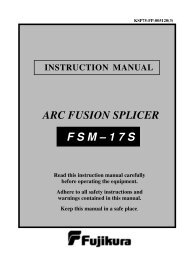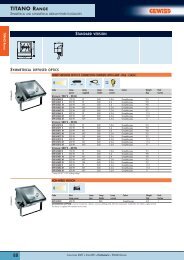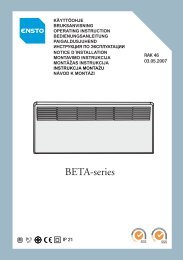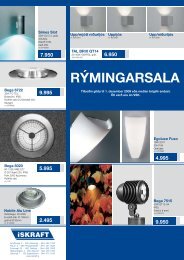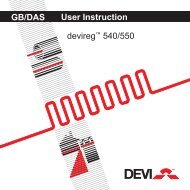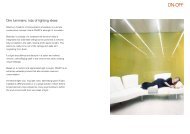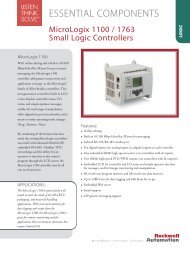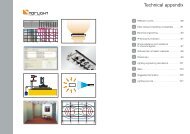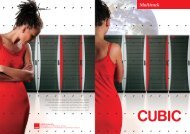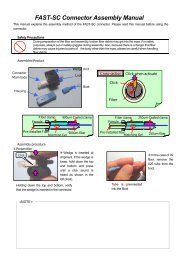analogue instruments
analogue instruments
analogue instruments
You also want an ePaper? Increase the reach of your titles
YUMPU automatically turns print PDFs into web optimized ePapers that Google loves.
The<br />
QUALITY GUARANTEE<br />
range of measuring <strong>instruments</strong> are manufactured in accordance with the standards directed by recognise a international organizations.<br />
MEASURING CIRCUITS (CEI EN 61010-1:2001-11)<br />
6<br />
Measuring <strong>instruments</strong> are subjected to WORKING VOLTAGES and transient stresses from the circuit to which they are connected during measurement.<br />
When the measuring circuit is used to measure MAINS, the transient stresses can be estimated by the location within the installation at<br />
which the measurement is performed. When the measuring circuit is used to measure any other electrical signal, the transient stresses must be<br />
considered by the user to assure that they do not exceed the capabilities of the measuring equipment.<br />
<strong>instruments</strong> belong to category III (CAT III - 600V AC et CAT III - 300V DC) considering the measures effected in internal houses<br />
(panel).<br />
The information concerned the measurement category and the RATED maximum NOMINAL WORKING VOLTAGE or RATED maximum NOMI-<br />
NAL CURRENT for such terminals,are putted near these terminals on a label.<br />
GENERAL TECHNICAL CHARACTERISTICS<br />
All the <strong>instruments</strong> present on this catalogue haven’t internal fuses protection. It is a matter of specialised technician to consider their<br />
installation (if necessary) relating to the declared self-consumption<br />
NORME<br />
The<br />
measuring <strong>instruments</strong> listed in this catalogue have been manufactured according to the following standards: CEI EN61010-1/CEI EN60051-1-2<br />
With regard to the dimensional characteristics of the <strong>instruments</strong> and shunts, reference is made to the DIN 43700/43718 standards.<br />
The most important among these standards are recalled in the following paragraphs relating to the electrical and mechanical characteristics of the<br />
<strong>instruments</strong>.<br />
TEST VOLTAGE - INSULATION<br />
The <strong>instruments</strong> are tested according to CEI EN 61010-1 with an effective voltage of 2000V at 50Hz for 1 minute.<br />
Greater Test and Insulation voltages can be provided on request for certain types of <strong>instruments</strong>.<br />
ACCURACY CLASS<br />
The accuracy class of the <strong>instruments</strong> is 1.5 unless otherwise specified, according to CEI EN 60688.<br />
Greater precision classes can be provided on request for certain types of <strong>instruments</strong>.<br />
The class of precision is given on the scale of each instrument.<br />
OVERLOAD<br />
The current coils of all the <strong>instruments</strong> are capable of withstanding over loading of up to 10 times the nominal current value for periods of less than<br />
1 second; and for up to 1,2 times the nominal value permanently.<br />
The voltage coils withstands a continuous over loading of up to 1,2 times the nominal voltage and an overloading of up to twice the nominal voltage<br />
for periods of less than 0,5 seconds (CEI EN 61010-1)<br />
For <strong>instruments</strong> with input by means of C.T., the overload can be greater as the transformer limits the peak of secondary current to values which<br />
are generally less than 10 In.<br />
The zerovoltmeters can withstand up to 4 times the full scale voltage for periods of less than 5 minutes.<br />
OPERATING TEMPERATURE<br />
The <strong>instruments</strong> satisfy the requisites of the IEC standards, par. 8.7.1 for which the operating temperature is 20°C +/-10°C. They can however function<br />
in continuous service without deterrioration and with an acceptable error of class, with temperatures ranging between -10 °C and +55°C.<br />
STORAGE TEMPERATURE<br />
The storage temperature should range from -40°C and +70°C. Temperatures which exceed the two limits can alter the chemical conditions of the<br />
siliconic fluid.<br />
HUMIDITY<br />
The <strong>instruments</strong> are suitable for functioning with a maximum relative humidity of 85% without condensation, at a temperature of +35°C for a maximum<br />
of 60 days per year.<br />
The relative average annual humidity value should not exceed 65% (DIN 40040 standards).<br />
The <strong>instruments</strong> used in tropicalized conditions can exceed the above-mentioned values and function with a relative maximum humidity of 95%<br />
and at a temperature of +35°C. In this case the average annual value of relative humidity should no exceed 75%<br />
The <strong>instruments</strong> used in tropicalized conditions are made to the DIN 40040 standards, according to that, these type of <strong>instruments</strong> must be protected<br />
against the entry of humidity; furthermore all the connection terminals, screws, washers, bolts and magnets are galvanically protected against<br />
the rust and the printed circuits (if presents) are protected with a special varnish type “Multicolor PC52”.<br />
ENVIRONMENTAL CONDITIONS<br />
The equipments are designed to be safe at least under the following conditions:<br />
- indoor use<br />
- altitude up to 2000 m, or above 2000 m if specified by the manufacturer (see clause D.9 for further information on Standars EN61010-1)<br />
- temperature 0°C to 40°C<br />
- maximun relative humidity 80% for temperatures up to 31°C decreasing linearly to 50% relative humidity at 40°C<br />
- mains supply voltage fluctuations not to exceed +/-10% of the nominal voltage -other supply voltage fluctuations as stated by the manufacturer<br />
- transient overvoltages according to installation categories (overvoltage categories) I, II and III (see Annex J on Standards EN61010-1).<br />
For mains supply the minimun and normal category is II<br />
- pollution degree 1 or 2 in accordance with IEC 664<br />
RESISTANCE TO VIBRATION<br />
The <strong>instruments</strong> in the catalogue have passed resistance to vibration tests as established by the CEI 50-4 standards.<br />
RESISTANCE TO SHOCK<br />
The <strong>instruments</strong> have passed shock resistance tests.<br />
MOUNTING POSITION<br />
This series of <strong>instruments</strong> are made to function in a vertical position.Thanks to perfect balancing they can also be mounted horizontally.<br />
Please state mounting method when ordering.<br />
FRONT HOUSING FRAME<br />
The front frame is narrow, according to been DIN 43718/s, and black in colour. The thermoplastic material has the same characteristics as that<br />
used for the housing.<br />
POINTERS<br />
The pointers of the <strong>instruments</strong> conform to the DIN 43802 standards. The pointer reaction time is about ≤2 seconds.



